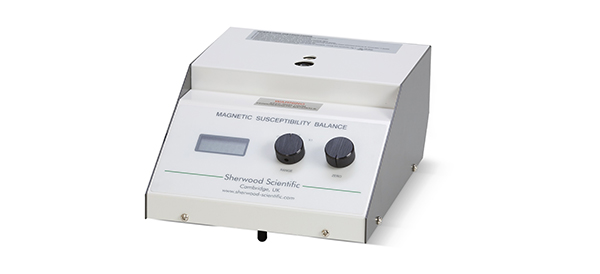MSB MK1

MSB MK1
Product Overview
Magnetic Susceptibility is defined as:
“The ratio of the intensity of magnetism induced in a substance to the magnetising force or intensity of field to which it is subject.”
Basic Principles of Magnetic behaviour
Based on their magnetic properties, all substances can be classified into one of three groups, those attracted by a strong magnetic field, known as paramagnetic, those repelled, designated diamagnetic, and finally, the most recognised class, ferromagnetic, unique in their ability to retain their own magnetic field. Ferromagnets are able to retain a permanent magnetic field since their free electrons are in close proximity and remain aligned even after the external magnetic field is removed.
Unlike the ferromagnets, the magnetic properties of the diamagnetic or paramagnetic materials could only be observed and measured when these samples are held within a magnetic field; applied externally.
The MK 1 Magnetic Susceptibility Balance has proven to be the ideal instrument for use in teaching laboratories throughout the world where the reduced amounts of chemicals required for an experiment saves on material costs and minimises waste products disposal.
Highlights
Compared with the traditional Gouy balance methods the Sherwood Scientific MK 1 Magnetic Susceptibility Balance exhibits many advantages:
- Ease and speed of use. Place the sample tube in the balance and get an immediate digital read-out.
- Measurement can be made on a wide range of diamagnetic and paramagnetic materials.
- The fixed sample tube allows susceptibility measurement of solids, liquids and gases.
- The technique has comparable sensitivity and is as accurate as traditional methods of measurement.
- The cost of the balance is significantly lower than a complete Gouy balance system.
- The instantaneous digital read-out can be used to calculate magnetic susceptibility using a simple equation. This gives significant time savings in both set-up and measurement.
- Small sample size – the balance normally works with a sample weight of around 250mg but, by using a thin-bore sample tube, as little as 50mg is required to give an accurate measurement.
- Analogue output. Using a flow cell, allows a chemical reaction resulting in a change of susceptibility to be monitored dynamically. This allows new applications to be investigated, for example, redox reactions.
- The equipment is compact, lightweight and hence easily portable. Only a 110V or 240V mains supply is required.
|
Size in cm (unpacked)
|
22w x 28d x 14h
|
|
Size in cm (packed)
|
34w x 45d x 26h
|
|
Weight (unpacked)
|
3 Kg (~ 7 lbs)
|
|
Weight (packed)
|
4.5 Kg (~ 10 lbs)
|
|
Measurement range
|
Approx. ±2×10-5 to ±5×10-8 arbitrary units
|
|
Amount of sample required for accurate determination of Magnetic Susceptibility
|
70µl (min)
300µl (max)
Approx. 0.04g solid (depending upon density)
Approx. 0.025g solution
|
|
Detection limits
|
Approx. 10x lower than above
(depending upon Magnetic Susceptibility)
|
|
Outputs
|
Digital display
Analogue output
|
|
Magnetic Field Strength
|
3.5 kGauss
|
The MSB Mk1 is supplied with a Universal Power Supply accepting input voltages over the range 100 – 240V AC, 50/60Hz, with output to the instrument of 12V DC.
Siting of Balance
Before removing the Travel Clamp it is important to consider the siting of the balance. The balance is sensitive to external magnetic fields; many stray constant fields can be adjusted for, however stray variable fields such as those emitted from conventional magnetic susceptibility balances using an electromagnet, or an Electron Spin Resonance spectrometer cannot be adjusted for and will cause the balance readings to fluctuate.
Other sources of variable magnet fields include computers, mobile phones, as well as more benign-seeming moving metal objects such as doors opening and closing. If the balance is placed on a bench with drawers, ensure that ferromagnetic objects are not situated directly below.
If in doubt, once the balance it installed check whether the zero reading of the balance changes when the external magnetic field is varied. If the variation is too great, refit the Travel Clamp and try installing the balance in another location.
For best results, the balance should be placed on a level and stable surface free from vibration in an environment not subject to chemical fumes or rapid changes in temperature.